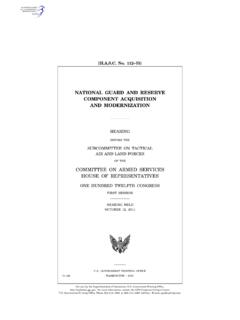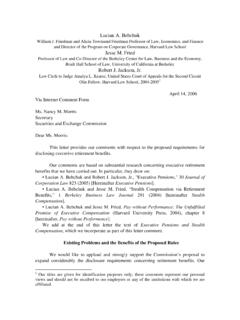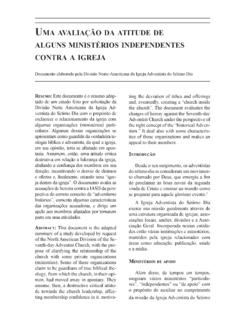Transcription of IDEOLOGICAL SEGREGATION ONLINE AND OFFLINE M G
1 IDEOLOGICAL SEGREGATION ONLINE AND OFFLINE MATTHEWGENTZKOW ANDJESSEM. SHAPIROW euse individual and aggregate data to ask how the Internet is changingthe IDEOLOGICAL SEGREGATION of the American electorate. Focusing on ONLINE newsconsumption, OFFLINE news consumption, and face-to-face social interactions, wedefine IDEOLOGICAL SEGREGATION in each domain using standard indices from theliterature on racial SEGREGATION . We find that IDEOLOGICAL SEGREGATION of ONLINE newsconsumption is low in absolute terms, higher than the SEGREGATION of most offlinenews consumption, and significantly lower than the SEGREGATION of face-to-faceinteractions with neighbors, co-workers, or family members. We find no evidencethat the Internet is becoming more segregated over : D83, INTRODUCTIOND emocracy is most effective when citizens have accuratebeliefs (Downs 1957; Becker 1958). To form such beliefs, individ-uals must encounter information that will sometimes contradicttheir preexisting views.
2 Guaranteeing exposure to informationfrom diverse viewpoints has been a central goal of media policy inthe United States and around the world (Gentzkow and Shapiro2008).New technologies such as the Internet could either increaseor decrease the likelihood that consumers are exposed to diversenews and opinion. The Internet dramatically reduces the cost ofacquiring information from a wide range of sources. But increas-ing the number of available sources can also make it easier forconsumers to self-segregate ideologically, limiting themselves tothose that are likely to confirm their prior views (Mullainathanand Shleifer 2005).The possibility that the Internet may be increasing ideologi-cal SEGREGATION has been articulated forcefully bySunstein(2001,4 5): Our communications market is rapidly moving toward asituation where people restrict themselves to their own pointsof view liberals watching and reading mostly or only liberals; This article would not have been possible without the generous support of JimCollins at Mediamark Research and Intelligence.
3 We thank our dedicated researchassistants for invaluable contributions to this project, and Jim Webster, HenryFarrell, Kelly Garrett, Markus Prior, and numerous seminar participants forhelpful comments. This research was funded by the Initiative on Global Markets,the George J. Stigler Center for the Study of the Economy and the State, the CentelFoundation/Robert P. Reuss Faculty Research Fund, and the Neubauer FamilyFoundation, all at the University of Chicago Booth School of The Author(s) 2011. Published by Oxford University Press, on the behalf of Presidentand Fellows of Harvard College. All rights reserved. For Permissions, please email: Quarterly Journal of Economics(2011) 126, 1799 1839. Access publication on November 3, at University of Chicago Libraries on December 9, 2011 from 1800 QUARTERLY JOURNAL OF ECONOMICS moderates, moderates; conservatives, conservatives; Neo-Nazis,Neo-Nazis. This limits the unplanned, unanticipated encounters[that are] central to democracy itself (p.)
4 9).Sunstein(2001) alsonotes that the rise of the Internet will be especially dangerousif it crowds out other activities where consumers are more likelyto encounter diverse viewpoints. He argues that both traditionalmedia such as newspapers, magazines, and broadcasters, andface-to-face interactions in workplaces and local communities arelikely to involve such diverse this article, we assess the extent to which news consump-tion on the Internet is ideologically segregated, and compareonline SEGREGATION with SEGREGATION of both traditional media andface-to-face interactions. For each outlet in our sample (a newspa-per, a particular website), we measure the share conservative: theshare of users who report their political outlook as conservative, among those who report being either conservative or liberal. We then define each individual sconservative exposureto be theaverage share conservative on the outlets she visits.
5 For example,if the only outlet an individual visits is , her exposureis defined as the share conservative on If she visitsboth and , her exposure is the average ofthe conservative shares on these two sites. Our main measure ofsegregation is the isolation index (White 1986; Cutler, Glaeser,and Vigdor 1999), a standard metric in the literature on racialsegregation. In our context, the isolation index is equal to theaverage conservative exposure of conservatives minus the aver-age conservative exposure of liberals. If conservatives only and liberals only visit , the isolationindex will be equal to 100 percentage points. If both conservativesand liberals get all their news from , the two groups willhave the same conservative exposure, and the isolation index willbe equal to use aggregate 2009 data on website audiences from com-Score, supplemented with micro data on the browsing behavior ofindividuals from 2004 to 2008.
6 To measure OFFLINE consumption,1. People who rely on [newspapers, magazines, and broadcasters] have arange of chance diverse others, and also exposure to materialsand topics that they did not seek out in advance (Sunstein 2001, 11). Thediverse people who walk the streets and use the parks are likely to hear speakers arguments about taxes or the police; they might also learn about the nature andintensity of views held by their fellow you go to work or visit is possible that you will have a range of unexpected encounters (p. 30). at University of Chicago Libraries on December 9, 2011 from IDEOLOGICALSEGREGATION1801we use 2008 individual-level data from Mediamark Research andIntelligence on consumption of newspapers, magazines, broadcasttelevision, and cable. To measure face-to-face interactions, we usedata on the political views of individuals acquaintances and po-litical discussants as reported in the 2006 General Social Surveyand the 1992 Cross-National Election consumption ONLINE is far from perfectly average Internet news consumer s exposure to conservativesis 57%, slightly to the left of the adult population.
7 The aver-age conservative s exposure is , similar to a person who getsall her news from The average liberal s exposure , similar to a person who gets all her news from isolation index for the Internet is percentage points, thedifference between the average conservative s exposure and theaverage liberal s consumers with extremely high or low exposure arerare. A consumer who got news exclusively from have a more liberal news diet than 95% of Internet newsusers, and a consumer whogot news exclusively from have a more conservative news diet than 99% of Internetnews isolation index we estimate for the Internet is higherthan that of broadcast television news ( ), cable television news( ), magazines ( ), and local newspapers ( ) and lower thanthat of national newspapers ( ). We estimate that eliminatingthe Internet would reduce the IDEOLOGICAL SEGREGATION of news andopinion consumption across all media from to SEGREGATION is somewhat higher than that of a socialnetwork where individuals matched randomly within counties( ) and lower than that of a network where individuals matchedrandomly within ZIP codes ( ).
8 It is significantly lower thanthe SEGREGATION of actual networks formed through voluntaryassociations ( ), work ( ), neighborhoods ( ), or family( ). The Internet is also far less segregated than networks oftrusted friends ( ) and political discussants ( ).Using our micro data sample, we estimate ONLINE segregationback to 2004 and find no evidence that the Internet is becomingmore segregated over explore two economic mechanisms that limit the extentof ONLINE SEGREGATION . First, most ONLINE news consumption is con-centrated in a small number of relatively centrist sites. Much ofthe previous discussion of Internet SEGREGATION has focused on the at University of Chicago Libraries on December 9, 2011 from 1802 QUARTERLY JOURNAL OF ECONOMICS long tail of political blogs, news aggregators, and activist confirm that these sites are often ideologically extreme, butfind that they account for a very small share of ONLINE consump-tion.
9 Second, a significant share of consumers get news from mul-tiple outlets. This is especially true for visitors to small sites suchas blogs and aggregators. Visitors of extreme conservative sitessuch as and are more likelythan a typical ONLINE news reader to have visited of extreme liberal sites such as are more likely than a typical ONLINE news reader tohave visited the final section of results, we present a series of robust-ness checks. We also consider the possibility that SEGREGATION atthe level of individual stories may differ from SEGREGATION at thelevel of the news outlet and present several pieces of evidencesuggesting that story-level SEGREGATION is unlikely to be verydifferent from the outlet-level SEGREGATION we conclude with an important caveat: none of the evidencehere speaks to the way people translate the content they en-counter into beliefs. People with different ideologies see simi-lar content, but both Bayesian (Gentzkow and Shapiro 2006;Acemoglu, Chernozhukov, and Yildiz 2009) and non-Bayesian(Lord, Ross, and Lepper 1979) mechanisms may lead peoplewith divergent political views to interpret the same results inform both popular and theoretical discus-sions of the political impact of the increased media and Shleifer(2005),Sobbrio(2009), andStone(2010) write down theoretical models of media markets in whichincreasing the number of outlets may lead consumers to becomemore segregated ideologically.
10 Public officials ( ,Leibowitz2010) and commentators ( ,Brooks 2010) routinely warn of thedangerous effects of IDEOLOGICAL isolation in news consumption onthe health of our (2001), Kohut(2004), VonDrehle(2004), Carr(2008), andFriedman(2009), among others,have argued that proliferation of news sources on the Internetmay be increasing that our knowledge, ours is the first study to use detailed dataon the IDEOLOGICAL composition of news website visitors to compareideological SEGREGATION ONLINE and OFFLINE . Apart fromLawrence,Sides, and Farrell s(2010) analysis of the IDEOLOGICAL polariza-tion of blog audiences, most evidence on IDEOLOGICAL SEGREGATION at University of Chicago Libraries on December 9, 2011 from IDEOLOGICALSEGREGATION1803online comes from data on content or link structures rather thanconsumption ( ,Adamic and Glance 2005; Hargittai, Gallo, andKane 2008).2 Alarge literature considers the causes and effects of polit-ical polarization (Glaeser and Ward 2006; McCarty, Poole, andRosenthal 2006), whichPrior(2008),Campante and Hojman(2010), and others relate to the structure of the media growing literature in economics studies the effects of the newsmedia on public policy ( ,Stromberg 2004; Stromberg andSnyder 2010), political beliefs and behavior (Prior 2005; Gentzkow2006; DellaVigna and Kaplan 2007; Knight and Chiang 2008), andsocial capital (Olken 2009).



















